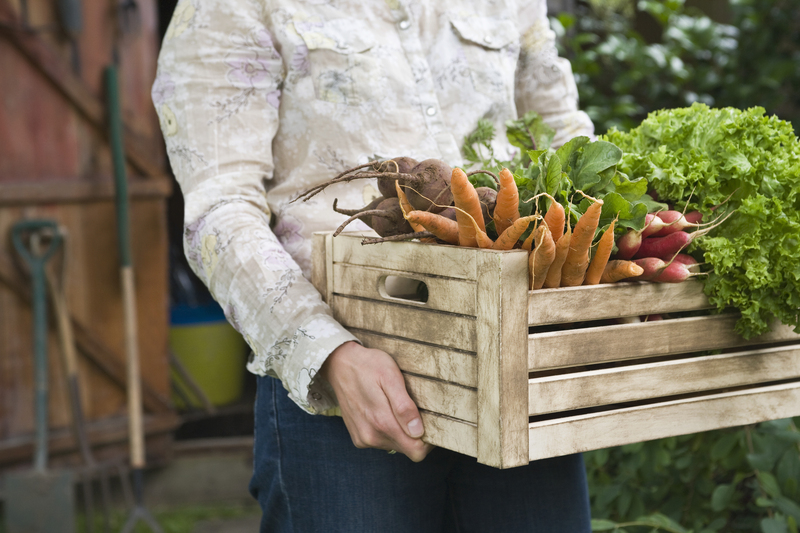How Vertical Gardens Can Improve Your Lifestyle
Posted on 28/08/2025
How Vertical Gardens Can Improve Your Lifestyle
Vertical gardens are more than just a stylish trend; they symbolize a shift towards a greener, healthier, and more sustainable way of living. Whether you live in a spacious suburban home or a compact city apartment, integrating vertical gardens into your environment can bring profound benefits to your lifestyle. In this comprehensive article, we will explore the multifaceted advantages of vertical gardening, offer expert tips, and explain how vertical wall gardens can transform your living space for the better.

What Are Vertical Gardens?
Vertical gardens, also known as living walls or green walls, are innovative gardening systems where plants grow on vertically suspended panels, typically placed against an interior or exterior wall. Unlike traditional horizontal gardens, vertical green walls make use of upward space, allowing you to cultivate plants even in tight or unconventional areas.
Types of Vertical Gardens
- Indoor living walls
- Outdoor green facades
- Modular panel systems
- Pocket and pouch planters
- Hydroponic vertical gardens
- DIY trellis and pallet gardens
Each type of vertical garden can be customized according to your space, climate, and aesthetic preferences.
The Lifestyle Benefits of Vertical Gardening
1. Enhancing Your Physical and Mental Health
- Improved Air Quality: Vertical gardens act as natural air purifiers. Plants absorb carbon dioxide and release oxygen, effectively filtering indoor air pollutants such as benzene, formaldehyde, and trichloroethylene. Cleaner air promotes better respiratory health and overall well-being.
- Reduction in Mental Stress: Numerous studies show that exposure to greenery and nature--such as that offered by living plant walls--decreases stress levels, enhances mood, and improves cognitive function. A living wall in your home or office fosters tranquility and relaxation.
- Encouraging Physical Activity: Vertical gardens often require regular care like watering, pruning, and harvesting. This gentle form of physical activity keeps you engaged, enhances dexterity, and even burns calories.
2. Maximizing Limited Space
One of the most significant advantages of vertical gardening is space optimization. For urban dwellers with limited floor acreage, vertical green walls offer a creative solution to grow herbs, flowers, and vegetables without sacrificing valuable living space. You can install vertical gardens on balconies, patios, corridors, or even within your living room.
- Urban Gardening Made Possible: Vertical garden systems can transform any bare wall or fence into a lush, productive garden.
- Flexibility and Customization: If you move houses, many modular vertical garden systems are portable and easy to relocate.
3. Aesthetic and Design Appeal
Vertical gardens create a stunning visual impact and can serve as living works of art. From simple arrangements of lush ferns to elaborate mosaics of succulents, there's endless scope for creativity.
- Modernize Your Decor: A live green wall acts as a bold statement piece, instantly elevating any space with vibrancy and texture.
- Increase Property Value: Professionally installed vertical gardens can enhance the attractiveness of your property, potentially raising its market value.
Environmental Advantages of Vertical Green Walls
- Reduction of Urban Heat: Plants absorb sunlight and keep walls cool, reducing the urban heat island effect. This is particularly valuable in densely-populated cities.
- Noise Insulation: A thick layer of foliage acts as a natural sound barrier, muffling exterior noise and improving your indoor environment.
- Promoting Biodiversity: Vertical gardens attract pollinators like bees, butterflies, and birds, promoting a healthier local ecosystem.
- Stormwater Management: Plants absorb rainwater, reducing runoff and mitigating the risk of urban flooding.
Vertical Vegetable and Herb Gardens: Grow Your Own Food
Another remarkable way in which vertical gardening can improve your lifestyle is by empowering you to grow your own fresh produce. Even if you only have a few feet of bare wall, you can cultivate herbs, cherry tomatoes, strawberries, lettuce, and much more.
- Healthier Eating: Having fresh produce at arm's reach encourages cooking at home and eating more nutrient-rich foods.
- Saves Money: Homegrown vegetables and herbs reduce grocery bills, and you can be sure your food is free from harmful chemicals.
- Reduces Food Miles: The environmental impact of your meals is significantly reduced when your food is grown where you live.
How to Start Your Own Vertical Garden
Step 1: Assess Your Space
- Identify a suitable wall or fence with enough sunlight (most edibles and flowering plants need 4-6 hours daily).
- Consider whether you want an indoor or outdoor vertical wall garden.
Step 2: Choose the Right Vertical Gardening System
- Pocket Planters: Simple fabric or felt "pockets" that attach to walls are perfect for herbs and small flowers.
- Modular Panels: Pre-made systems with individual planters or inserts, ideal for larger installations.
- Trellis and Climbing Systems: Support vining plants like peas, beans, or morning glory for an ornamental effect.
- DIY Recyclables: Repurpose old pallets, bottles, or gutters into eco-friendly vertical gardens.
Step 3: Select Suitable Plants
- Herbs: Basil, thyme, oregano, mint, parsley, cilantro.
- Vegetables: Lettuce, spinach, kale, peppers, cherry tomatoes.
- Flowers and Foliage: Ferns, petunias, ivy, succulents, orchids.
Note: Always consider your climate, light exposure, and indoor/outdoor location when selecting plants.
Step 4: Install and Maintain Your Vertical Garden
- Mount your chosen vertical garden structure securely.
- Use high-quality, well-draining soil and appropriate fertilizers.
- Water consistently. Many vertical systems require frequent watering due to increased exposure and quick drainage.
- Prune regularly and remove unhealthy plants promptly to avoid disease spread.
- Check for pests and take action as needed, preferably using organic solutions.
Creative Design Tips for Living Walls
- Color Play: Combine different shades of green, or add flowering plants for seasonal bursts of color.
- Texture and Layering: Mix leaf shapes and plant heights for a three-dimensional look.
- Functional Features: Use edible plants, fragrant herbs, or cascading vines for both beauty and utility.
- Lighting: Use LED grow lights for indoor installations to support healthy plant growth year-round.
Maintaining a Healthy Vertical Garden
- Install an irrigation system for large or outdoor walls, or water by hand for smaller displays.
- Fertilize sparingly; over-fertilization is a common cause of plant stress.
- Ensure good air circulation to reduce mold or mildew risk, especially indoors.
Vertical Gardens for Workspaces and Public Spaces
The benefits of vertical gardens are not limited to homes. Vertical plant walls have become increasingly popular in offices, hotels, hospitals, schools, and restaurants. Here's why:
- Improved Productivity: Studies have shown that exposure to greenery in the workplace leads to increased concentration, creativity, and job satisfaction.
- Enhanced Brand Image: Sustainable features such as vertical gardens set your business apart and communicate your commitment to environmental responsibility.
- Healthier Indoor Environment: Living walls in public places help reduce the spread of germs by improving air quality and regulating humidity.
Sustainability: A Greener Path Forward
- Promoting Eco-Friendly Living: Growing your own food, composting, and using organic practices with vertical gardening reduce your ecological footprint.
- Energy Efficiency: Outdoor vertical gardens on building facades act as natural insulation, lowering cooling costs in summer and heating expenses in winter.
Common Challenges and Solutions in Vertical Gardening
- Watering Issues: Solution: Set up an automated drip irrigation system or self-watering planters for easy maintenance.
- Pest Management: Solution: Choose pest-resistant plant varieties and use natural deterrents like neem oil or insecticidal soap.
- Weight Concerns: Solution: Use lightweight soil mixes and ensure your walls are structurally sound to support the garden's weight.
- Sunlight Limitations: Solution: Opt for shade-tolerant plants or invest in grow lights for indoor green walls.
Real-Life Success Stories
- Family Wellness: Families with children have found that backyard vertical vegetable gardens encourage kids to eat more greens while teaching valuable lessons about biology and responsibility.
- Urban Apartments: City dwellers have reported feeling less confined and more at peace after installing lush balcony or interior living walls in their apartments.
- Corporate Offices: Forward-thinking companies have noticed a measurable boost in employee morale and retention after introducing vertical garden features.

Frequently Asked Questions About Vertical Gardens
- Are vertical gardens easy to maintain?
Yes. While they do require regular watering, pruning, and fertilization, modern modular systems make maintenance straightforward. - Are vertical gardens expensive to install?
Basic DIY setups can be very affordable, while large, professionally installed systems may incur higher upfront costs but deliver long-term value. - What plants do best in vertical wall gardens?
Herbs, leafy greens, ferns, succulents, and some flowers are excellent choices. Always consider the light and climate conditions of your location. - Can vertical gardens survive indoors?
Absolutely! With the right light and care, many plant species thrive indoors when grown on vertical planters.
Conclusion: Embrace a Healthier, Greener Lifestyle with Vertical Gardens
Vertical gardens offer a transformative approach to modern living. They enrich your home, workspace, or communal area with beauty, improve your health by purifying the air and reducing stress, promote sustainability, and enable you to grow your own fresh produce in minimal space. Whether you are looking to enhance your wellbeing, connect with nature, or simply create an engaging focal point in your environment, living walls and vertical green gardens are an investment in both present-day enjoyment and future sustainability.
Start your vertical gardening journey today and watch your environment--and lifestyle--bloom!

